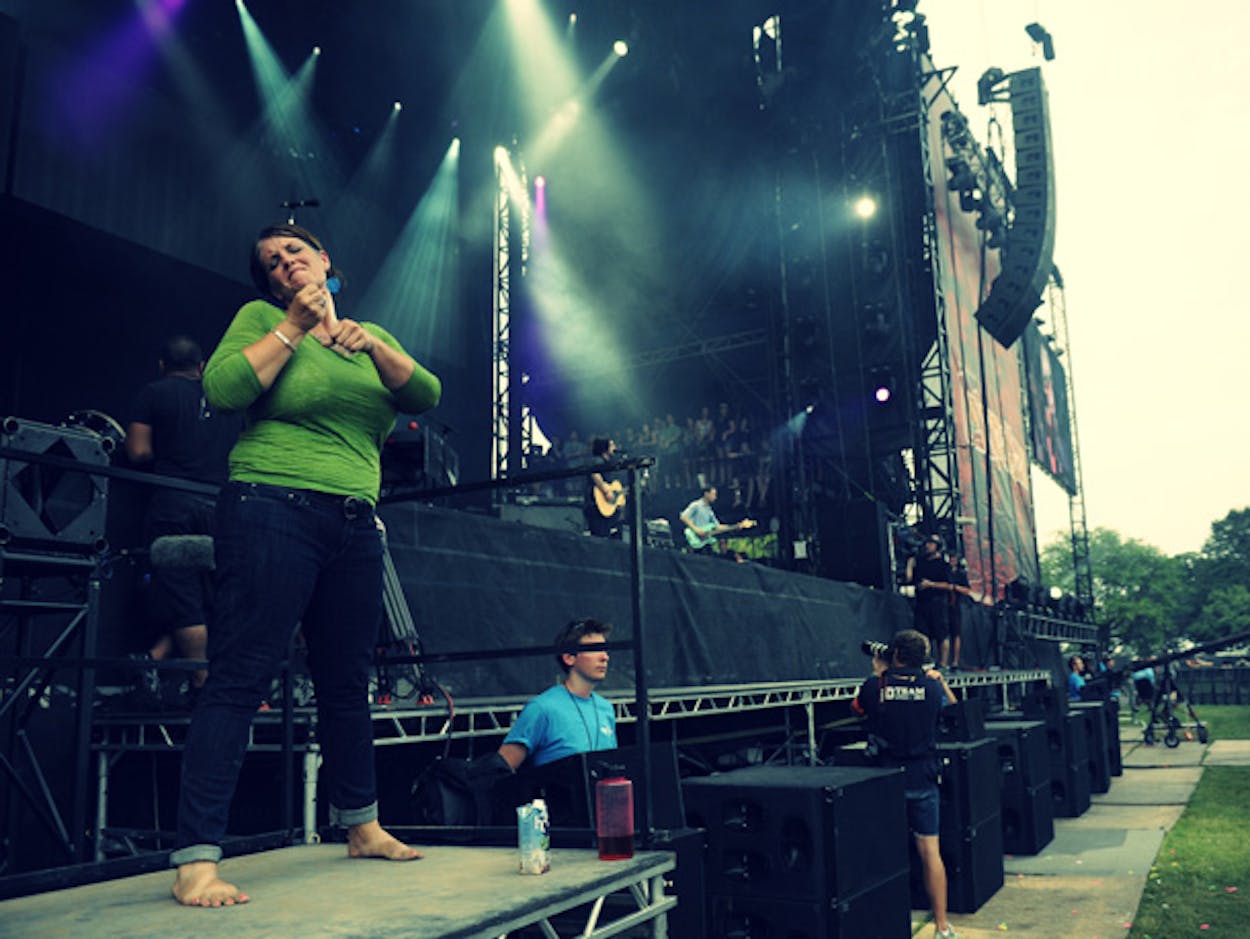On the last night of Chicago’s 2012 Lollapalooza music festival, the sun set over a crowd of thousands who had stood for hours waiting to see Jack White, the headliner. A figure strode onto the stage, tipping off a cascade of cheers.
But it was not the alabaster-skinned guitarist; it was Barbie Parker, the festival’s lead sign language interpreter.
The Texas native, along with members of her Austin-based company, LotuSIGN, had interpreted more than twenty bands’ sets for deaf and hard of hearing festival attendees that weekend. As evidenced by the positive reception she received, her interpretations had won over a good portion of the hearing audience as well.
At live music shows, the 45-year-old Parker does not just sign lyrics—she communicates the entire musical experience. She mouths the words. She plays air guitar and air drums. She jams along with the bands.
“Music is such a large part of who I am,” Parker said. “I want to be able to open up that experience.”
Parker was bored in her accounting job and had two young children when she enrolled in her first formal American Sign Language class at San Antonio College about twenty years ago. She became fascinated with interpretation after reading a book about it at her local library and, in a chance encounter just hours after reading it, met the sister of a friend who happened to be an American Sign Language interpreter.
Parker is now an integral part of the Austin deaf community. Her two adult sons are proficient in ASL, and her company has provided sign language interpretation at music festivals across the country for several years. Next week she and other LotuSIGN interpreters will take the stage with artists at the South by Southwest Music Festival in Austin for the sixth year in a row.
The number of deaf and hard of hearing music fans taking advantage of interpretation at free shows held at Auditorium Shores as part of SXSW has risen noticeably in the past few years, said Frank Schaefer, the officer manager for the festival. That growth can be attributed, at least in part, to the rise of interpreters who specialize in this kind of work.
A good interpreter is adept at signing, but Parker also wants her team to impart the emotions and feelings music conveys. Lauren Kinast, 44, who gradually lost her hearing, attended a Rolling Stones concert worked by Parker’s group. She listened to the Stones growing up, but when Kinast saw Parker’s LotusSIGN interpret the band’s music, she came away with a greater appreciation of the band.
“Everything made it different, better,” she typed in a chat interview. “Having the songs interpreted in my language, understanding the emotions behind it, the meaning behind it and being a part of the concert experience just took my love for them several notches up.”
Parker first gained recognition in the mid-2000s for interpreting music at the funeral for the parent of a well-known member of the Austin deaf community. At one point during the ceremony, she needed to sign an emotional musical performance.
“The singer got inspired, so the interpreting had to get inspired,” Parker said. The signing seemed to further stir the singer, which further moved Parker. “There was a kind of reverb,” she said. “The deaf audience was just—I just saw these jaws drop open like, ‘Oh, that’s what it’s like.’”
After that, she began receiving requests to interpret at weddings, children’s recitals and, of course, live shows. In 2007 she started her own company, Alive Performance Interpreting, which in 2009 became LotuSIGN.
“They’re five-star interpreters,” said Stacy Landry, the program manager for local government deaf and hard of hearing services in Travis County. (Parker has obvious clout in the field—her interpreting services were used in January at President Barack Obama’s inauguration speech in Washington D.C.)
LotuSIGN interpreters specialize in analyzing lyrics to find the artist’s intent for a song. But sign language interpretation, no matter where it takes place, is about more than translating words into gestures and signs. The interpreter must communicate an overall experience by expressing the speaker’s tone; the meaning behind phrases and idioms; or if someone’s cell phone interrupted an otherwise silent lecture hall.
One year, Parker interpreted at a Sheryl Crow concert held in celebration of one of Lance Armstrong’s Tour de France titles. He was asked to take over playing the drums for one of Crow’s songs.
“Well,” Parker said, “he wasn’t any good.”
Parker let the discomfort show on her face as she imitated Armstrong’s uneven drumming. She nodded subtly to assure perplexed members of the deaf audience that she was indeed doing this on purpose.
As the audience reacted, Parker saw a deaf man elbow the hearing man next to him and cringe. The hearing man nodded and made a similar pained face.
“They had this shared experience,” Parker said. The deaf man was truly part of the crowd.
Parker’s company works to mentor others in the hopes of increasing access to live events. “You can’t do it without a lot of experience,” she said. “It is the hardest work I have ever done.”
Watch Barbie Parker interpret Beyonce’s performance of the national anthem at the 2013 inauguration ceremony.






